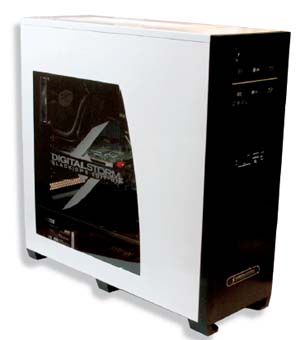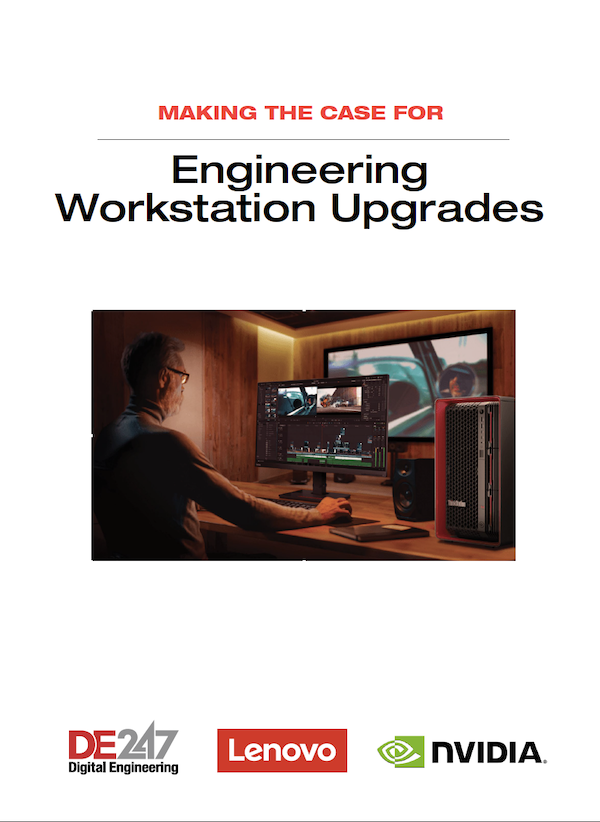Review: Digital Storm PROTUS
After a big impression, the Digital Storm PROTUS delivers mixed results.
Latest News
December 4, 2001
By David Cohn
 The Digital Storm PROTUS workstation is an assemblage of readily available components housed in a cavernous chassis. Image courtesy of David Cohn |
If you’ve never heard of Digital Storm before, join the club. The company has only been around since 2002, and focused primarily on building gaming systems based on “bleeding-edge technology.” But last summer, the Fremont, CA-based company announced a flagship line of workstations custom-built for engineering professionals — and we took Digital Storm up on its offer to run one of the new PROTUS systems through its paces.
We had seen photos of Digital Storm computers, but were still a bit awed when UPS delivered a box measuring 35 x 31 x 17 in. The case, with a high-gloss automotive finish, measured 9 x 24 x 24 in. and tipped the scales at more than 55 lbs. Yet we hardly had to wonder what the case contained, thanks to a 14 x 16 in. window in the removable left panel.
We also had to open the system immediately before ever turning it on to remove what a label prominently affixed to the outside of the packaging calls “unique and innovative ‘StormShield’ packaging material.” The packaging material turned out to be a bag of expanded foam.
Digital Storm is not really a manufacturer; it’s a system integrator, assembling computers from an assortment of components produced by others and readily available from various sources. For example, the huge case is the 800D manufactured by Corsair and available for around $300. The white Digital Storm paint job added $139 to the system price.
It’s What’s Inside that Counts
With such a big chassis, we expected to find all sorts of exotic components. What we found was an assortment of common parts and lots of extra space. The case provides a total of 11 drive bays, five 5.25-in. bays in the upper portion with front panel access, four 3.5-in. SATA hot-swap drive bays behind a hinged door, and two more 3.5-in. internal drive bays located in the bottom-front portion of the case.
A power switch occupies the space above the front panel drive bays, with an adjacent hinged panel that opens to reveal four USB 2.0 ports, an IEEE 1394 (FireWire connector), headphone and microphone jacks with jack detection and jack retasking, and a reset button. Below this, the uppermost two bays were filled with two optical drives made by LG: a Blu-ray writer/reader and a Blu-ray player/DVD writer. The bottommost bay housed a digital media reader, supporting virtually all currently available memory cards, and another USB 2.0 port.
Behind the door, one of the hot-swappable drive bays contained a 160GB Intel solid-state drive. At $880, this was a relatively expensive choice, but because it hosted the operating system, we expected to see a significant performance improvement. Unfortunately, our results were mixed: boot-up was no faster than other systems equipped with standard hard drives, but once running, Windows performance did seem brisk. Two of the other hot-swap bays contained 1TB Hitachi SATA 7200 rpm hard drives, each with a 32MB cache.
Inside the cavernous case, the motherboard looked almost lost, taking up slightly more than 25% of the interior space. Digital Storm offers 13 different motherboards from different manufacturers. Our system was based on an ASUS P6X58D Premium SLI motherboard with an Intel X58 chipset, featuring USB 3.0 and a 6Gb/second SATA controller. This board provides a single CPU socket, which in our system contained an Intel Core i7 Extreme Edition 980X 3.3GHz six-core CPU, the same processor as in the BOXX workstation we recently reviewed (see January 2011 DE, page 14).
CPU cooling was provided in the form of an Asetek liquid CPU cooler with a 120mm radiator (which actually took $26 off the system base price), although other cooling options run the gamut from simple fans and heat sinks to dual loop liquid cooling systems that can add as much as $1,094 to the system price.
According to the spec sheet included with our system, Digital Storm charged $199 to over-clock the CPU between 4.0GHz and 4.2GHz, but our tests indicated that the processor was running at a more sedate 3.5GHz.
The 750-watt Tech NPS power supply occupies the rear-bottom case corner. Digital Storm offers seven other choices.
There are lots of fans spinning inside the massive case. Two large internal fans and three smaller fans on the top of the case circulate air, aided by another fan in the power supply, the fan on the graphics board, and two more large fans within the CPU cooling system. Amazingly, the system proved relatively quiet after the initial boot-up, but we definitely knew it was running.
Digital Storm PROTUS Specs |
Results Don’t Justify the Price
Digital Storm pre-loaded Windows 7 Ultimate 64-bit edition (a $51 up-charge). At our request, the company also installed Windows XP Professional 64-bit (at no additional charge) so that we could run our complete benchmark suite, including the SPECapc SolidWorks tests. The SPEC Viewperf scores, which focus solely on graphics performance, were quite respectable, but fell short of setting any records. This was surprising, considering the caliber of the graphics card.
But on the SolidWorks test, which breaks out graphics, CPU and I/O performance separately, the Digital Storm PROTUS chalked up the best results we’ve ever recorded. Because this test more closely mirrors the type of performance users can expect to experience when running an MCAD application, it is definitely worth noting. Similarly, on our own AutoCAD rendering test, which clearly shows the advantages of hyper-threading, the Digital Storm PROTUS completed the renderings in just over 46 seconds, thanks to its equivalent of 12 CPU cores.
Because configuring a Digital Storm system is an a la carte process, we did not request any other option. Because most users would likely opt to purchase a keyboard and mouse along with their computer, we included Digital Storm’s $28 cost for a basic Logitech keyboard and mouse in our system price.
Digital Storm backs its systems with a limited warranty that covers labor costs for three years and defective part replacement for one year. However, many of the components included in the system have longer warranties. According to the spec sheet, our evaluation unit was covered under the Digital Storm four-year Platinum Care Extended Parts & Labor warranty, which extends labor coverage to four years and parts replacement to two years. It also includes lifetime U.S.-based technical support (M-F, 9 a.m. to 5 p.m. Pacific Standard Time) and lifetime labor free upgrades for components purchased from Digital Storm.
Toward the end of our evaluation period, the system could no longer see the solid-state hard drive and would no longer boot, causing us to put Digital Storm’s technical support to the test. Regrettably, no one was available to answer our call at 3:30 p.m. PST on a Tuesday. We left a message, but our call was not returned by the end of that business day. As we sent this issue to the printer, weeks later, our call still had not been returned.
As configured, our system priced out at $7,606, but discounts available at the time of our review dropped the final cost to $6,545. When it worked, the Digital Storm PROTUS workstation turned in excellent performance. But the experience left us with very mixed feelings. As an assemblage of parts, the completed system lacks independent software vendor (ISV) certification. And if you set out to build this system yourself, you could purchase all of the components for around $4,000.
The poor response to our support call was the decisive mark against this system, making it difficult to recommend the Digital Storm PROTUS for critical engineering applications.
More Info:
Digital Storm
David Cohn is the technical publishing manager at 4D Technologies. He also does consulting and technical writing from his home in Bellingham, WA, and has been benchmarking PCs since 1984. He’s a contributing editor to Desktop Engineering and the author of more than a dozen books. You can contact him via email at [email protected] or at DSCohn.com.
Subscribe to our FREE magazine, FREE email newsletters or both!
Latest News
About the Author
David Cohn is a consultant and technical writer based in Bellingham, WA, and has been benchmarking PCs since 1984. He is a Contributing Editor to Digital Engineering, the former senior content manager at 4D Technologies, and the author of more than a dozen books. Email at [email protected] or visit his website at www.dscohn.com.
Follow DE





